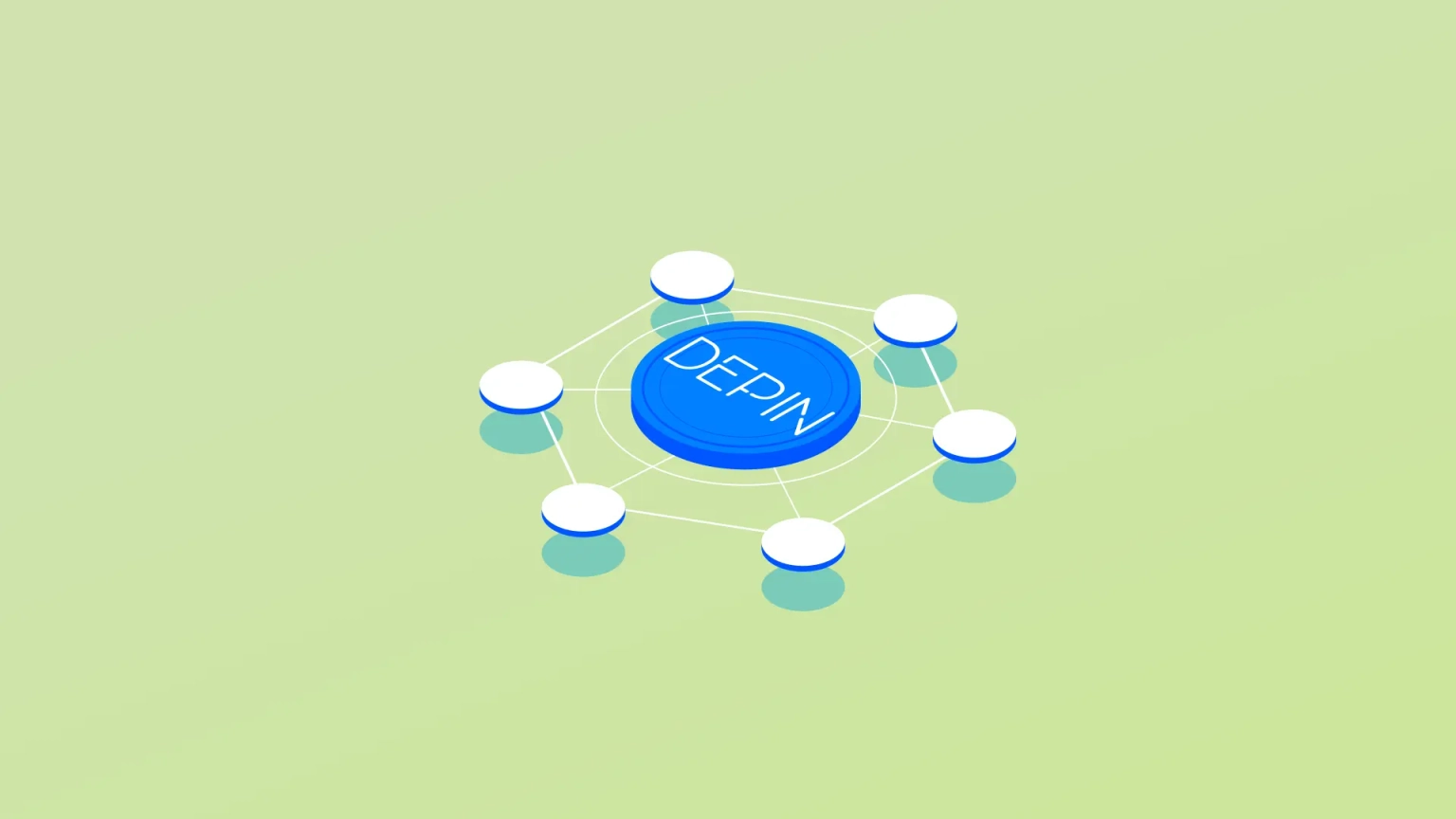
Understanding EIP-3074 and Its Benefits
A deep dive into EIP-3074, an Ethereum proposal that enables sponsored transactions
Youtube Video
Playing the video that you've selected below in an iframe

A detailed guide on DePin, its benefits, challenges, key projects, and future potential.
Blockchain technology was initially introduced as a platform for smooth peer to peer monetary transactions without the need for any centralized or legal entities. However, its application has rapidly expanded, giving rise to the Web3 revolution. It’s a new phase of the internet that emphasizes decentralization not only in finance but across various sectors of the real world.
This evolution has introduced a significant innovation with DePin, which seeks to decentralize critical physical infrastructures. This includes everything from data centers and storage facilities to communication lines and power grids. This potential for DePin to alter the management and operation of the fundamental assets promises enhanced efficiency, increased transparency, and more democratic control.
Through this blog, we aim to demystify DePin for our readers, exploring how it works, its benefits, the key players driving this innovation, and the challenges it faces. We hope to provide a comprehensive understanding of DePin and its potential impact on our daily lives and the broader infrastructure landscape.
Let’s begin.
DePin, or Decentralized Physical Infrastructure Network, represents a transformative approach to building and operating physical networks through Web3 technology. Utilizing the strengths of blockchain, DePin networks enable a decentralized model where individuals and businesses collectively contribute to and benefit from infrastructure services.
DePin leverages cryptocurrency incentives to encourage participation in these networks. Participants can contribute by using their own devices, such as hard drives, wireless nodes, or specialized hardware like in-car tracking devices, which integrate into the broader network infrastructure.
From decentralized car-sharing networks composed of electric vehicles to collaborative energy solutions that connect individual solar energy producers, DePin networks can support a wide array of services. These networks could manage decentralized grid systems or even power community-driven mapping services, integrating everyday activities with the decentralized web.
Furthermore, as a potential evolution of the Internet of Things (IoT) within the Web3 framework, DePin extends the concept of decentralized IoT. It connects the network infrastructure and allows users and device owners to collectively own and monetize their resources. This allows for more innovative, efficient, and cost-effective service models.
With applications stretching across computing, wireless, energy, AI, services, and sensors and encompassing real-world assets and blockchain infrastructures, DePin could revolutionize the way physical infrastructure networks are built and operated. The integration of these diverse sectors showcases its capability to adapt and innovate, providing a scalable and robust framework for the future of decentralized network services.
Here are the benefits of DePin:
Each transaction and decision within a DePin network is recorded on the blockchain, ensuring that all actions are transparent and verifiable. This level of transparency fosters trust among community members and empowers them to hold decentralized autonomous organizations (DAOs) accountable, making the networks more reliable and secure.
Blockchain protocols support decentralized networks and feature built-in consensus mechanisms that allow network participants to efficiently and reliably agree on the network's state. This decentralization eliminates the need for intermediaries, reduces overhead costs, and enhances resource allocation and infrastructure utilization. The incentive structures built into DePin also motivate participants to actively contribute their resources, further enhancing the network's efficiency.
DePin fundamentally transforms the development and management of infrastructure by empowering local communities through a bottom-up approach. Community members can fund, build, and manage their infrastructure, which democratizes access and fosters localized decision-making. This accelerates the adoption and scaling of DePin solutions, ensuring that the infrastructure developed meets the community's specific needs and preferences.
The decentralized nature of DePin networks means they are less susceptible to single points of failure. Whether it’s a natural disaster, a technical malfunction, or a cyberattack, the distributed infrastructure is designed to prevent complete system failures, ensuring more consistent and reliable access to essential services.
Tokenization in DePin opens up new investment and ownership opportunities within physical infrastructure projects. Individuals can purchase tokens that represent a stake in infrastructure assets, allowing them to earn returns on their investments and participate in governance through voting mechanisms.
DePin networks utilize crowdsourcing and peer-to-peer models to reduce the initial capital required to build infrastructure. They are open and permissionless, allowing anyone to join and contribute, which not only lowers entry barriers, but also increases the affordability and scalability of building infrastructure.
Filecoin is a prime example of a DePin application. It introduces a compensatory layer that rewards users with Filecoin tokens for renting out their spare storage space. This ensures data accessibility, such as digital files and transactions, regardless of geographic constraints, and also preserves data integrity against tampering by storing multiple decentralized copies.
Similarly, Arweave is also a leading project in decentralized file storage services, allowing users to share surplus disk space. Similarly, Hivemapper offers a decentralized mapping service that rewards contributors for capturing and sharing geographical data using dashcams.
Render, in the digital content rendering sector, uses personal graphics cards' unused computing power to render motion graphics and visual effects. The protocol distributes tasks across numerous nodes to expedite processing times and decrease workloads on individual systems.
Meanwhile, Helium expands connectivity through its decentralized wireless network, which incentivizes users to set up hotspots, thus broadening Internet coverage with a community-driven approach.
Power Ledger explores the energy sector with a peer-to-peer trading platform that decentralizes energy grids. By allowing individuals to trade energy without a central intermediary, Power Ledger facilitates more sustainable and efficient energy distribution.
Similarly, DIMO (Digital Infrastructure for Moving Objects) and PowerPod introduce novel concepts in vehicle data monetization and shared electric vehicle (EV) charging networks, respectively, enhancing utility and access in the transportation sector.
Bosch, Fetch.ai, and Peaq have collaborated in the development of the Bosch XDK110 Rapid Prototyping Kit, which is noteworthy in this field. This device is part of a broader initiative to integrate AI and blockchain to measure environmental conditions effectively, offering a decentralized approach to data collection and sharing.
These players demonstrate the dynamic and versatile applications of DePin technologies across different sectors, highlighting a significant shift towards decentralized, community-powered infrastructure solutions.
As DePin aligns with the Web3 principles, it faces significant challenges that could impede its widespread adoption. Addressing these obstacles is crucial for the future development and success of DePin projects.
One of the foremost challenges is the lack of clear regulatory frameworks for DePin and tokenized assets. Governments and regulatory bodies are still adapting to the rapid advancements in blockchain technologies. The absence of established regulations can create uncertainty for project developers and investors, potentially stifling innovation and growth.
DePin projects must also overcome substantial technical challenges, particularly in scaling and interoperability. While blockchain provides a robust base for developing decentralized networks, issues with scalability and transaction processing speeds can limit the practicality of DePin for large-scale infrastructure projects. Moreover, ensuring interoperability among diverse DePin projects remains a complex task that requires standardized protocols and collaborative development efforts to enable seamless communication and functionality across different blockchain platforms.
Transitioning from centralized to decentralized infrastructure networks involves changing longstanding user behaviors and trust patterns. Currently, centralized systems dominate the market, offering reliability and convenience that new DePin projects must match or exceed. Encouraging widespread user adoption requires demonstrating the benefits of DePin and ensuring a superior user experience and robust security measures.
Security vulnerabilities are a critical concern for DePin projects, as breaches or hacks can undermine user trust and the integrity of the entire network. To mitigate these risks, DePin projects need to implement stringent security protocols, develop secure smart contracts, conduct smart contract audits, and possibly integrate DeFi insurance to provide a safety net to users.
Looking forward, the future of DePin involves several strategic focuses and developments. Let’s see them in detail.
Effective collaboration among stakeholders—including governments, businesses, and the DePin community—is vital for navigating regulatory challenges and fostering an environment conducive to innovation. Pilot projects and open dialogues can play pivotal roles in crafting supportive regulatory frameworks that balance user protection with technological advancement.
To address DePin's technical challenges, continuous improvement in blockchain technology is critical. Innovations such as Layer-2 scaling solutions, enhanced consensus mechanisms, and advanced interoperability protocols can significantly improve the scalability, efficiency, and user friendliness of DePin networks.
DePin holds substantial promise for promoting sustainable infrastructure projects by incentivizing renewable energy and efficient resource use. As the ecosystem matures, the range of DePin applications could expand beyond telecommunications and energy to include healthcare and transportation, among others.
As previously mentioned, security vulnerabilities, hacks, and scams are a concern for the DePin projects. When it comes to the risks and threats in the Web3 space, Neptune Mutual is a project dedicated to mitigating the impacts of those issues.
Neptune Mutual is a DeFi insurance protocol that offers users cover policies to protect their assets. In cases of incidents that cause the loss of assets, we offer payouts to the victims. Since we based our project on the parametric model, where the payouts depend on predefined parameters, there’s no need to submit proof of loss.
We have a marketplace in the Ethereum, Arbitrum, and BNB Smart Chain networks from which users can purchase cover policies for different cover products. Projects that need to create cover pools to protect their community by allowing cover purchases can reach out to us.
For more information about Neptune Mutual, visit our website, follow us on X, and join our Discord community.